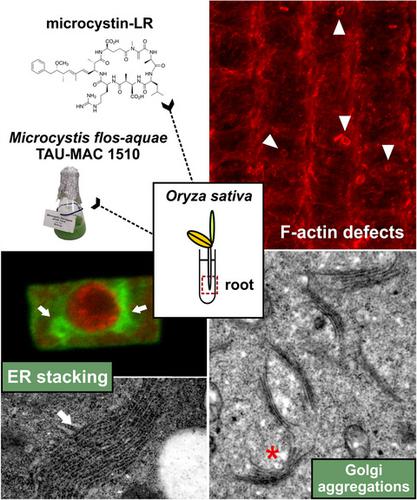当前位置:
X-MOL 学术
›
Plant Biol.
›
论文详情
Our official English website, www.x-mol.net, welcomes your
feedback! (Note: you will need to create a separate account there.)
The effects of microcystin-LR in Oryza sativa root cells: F-actin as a new target of cyanobacterial toxicity.
Plant Biology ( IF 4.2 ) Pub Date : 2020-04-08 , DOI: 10.1111/plb.13120 D Pappas 1 , S Gkelis 1 , E Panteris 1
中文翻译:

微囊藻毒素在稻根细胞中的作用:F-肌动蛋白是蓝藻毒性的新靶标。
更新日期:2020-04-08
Plant Biology ( IF 4.2 ) Pub Date : 2020-04-08 , DOI: 10.1111/plb.13120 D Pappas 1 , S Gkelis 1 , E Panteris 1
Affiliation

|
- Microcystins are toxins produced by cyanobacteria, notorious for negatively affecting a wide range of living organisms, among which several plant species. Although microtubules are a well‐established target of microcystin toxicity, its effect on filamentous actin (F‐actin) in plant cells has not yet been studied.
- Τhe effects of microcystin‐LR (MC‐LR) and an extract of a microcystin‐producing freshwater cyanobacterial strain (Microcystis flos‐aquae TAU‐MAC 1510) on the cytoskeleton (F‐actin and microtubules) of Oryza sativa (rice) root cells were studied with light, confocal, and transmission electron microscopy. Considering the role of F‐actin in endomembrane system distribution, the endoplasmic reticulum and the Golgi apparatus in extract‐treated cells were also examined.
- F‐actin in both MC‐LR- and extract‐treated meristematic and differentiating root cells exhibited time‐dependent alterations, ranging from disorientation and bundling to the formation of ring‐like structures, eventually resulting in a collapse of the F‐actin network after longer treatments. Disorganization and eventual depolymerization of microtubules, as well as abnormal chromatin condensation were observed following treatment with the extract, effects which could be attributed to microcystins and other bioactive compounds. Moreover, cell cycle progression was inhibited in extract‐treated roots, specifically affecting the mitotic events. As a consequence of F‐actin network disorganization, endoplasmic reticulum elements appeared stacked and diminished, while Golgi dictyosomes appeared aggregated.
- These results support that F‐actin is a prominent target of MC‐LR, both in pure form and as an extract ingredient. Endomembrane system alterations can also be attributed to the effects of cyanobacterial bioactive compounds (including microcystins) on the F‐actin cytoskeleton.
中文翻译:

微囊藻毒素在稻根细胞中的作用:F-肌动蛋白是蓝藻毒性的新靶标。
- 微囊藻毒素是蓝细菌产生的毒素,臭名昭著的是对多种生物造成负面影响,其中包括几种植物。尽管微管是微囊藻毒素毒性的公认目标,但尚未研究其对植物细胞中丝状肌动蛋白(F-actin)的作用。
- 微囊藻毒素(MC-LR)和微囊藻毒素生产淡水蓝藻菌株的提取物的Τhe效果(微囊金银花藻TAU-MAC 1510)对细胞骨架(F-肌动蛋白和微管)水稻(稻)根细胞用光,共聚焦和透射电子显微镜进行了研究。考虑到F-肌动蛋白在膜系统分布中的作用,还对提取物处理过的细胞的内质网和高尔基体进行了检查。
- F-肌动蛋白在MC-LR和提取物处理的分生和分化根细胞中均表现出时间依赖性变化,范围从迷失方向,束缚到环状结构的形成,最终导致F-肌动蛋白网络崩溃。更长的治疗。用提取物处理后,观察到微管的分解和最终解聚,以及染色质的异常凝结,其影响可能归因于微囊藻毒素和其他生物活性化合物。此外,提取物处理过的根部细胞周期进程受到抑制,特别影响有丝分裂事件。F-肌动蛋白网络紊乱的结果是,内质网元素似乎堆积并减少,而高尔基体细胞则聚集了。
- 这些结果表明,无论是纯形式还是提取成分,F-肌动蛋白都是MC-LR的主要靶标。膜内系统的改变也可归因于蓝细菌生物活性化合物(包括微囊藻毒素)对F-肌动蛋白细胞骨架的影响。









































 京公网安备 11010802027423号
京公网安备 11010802027423号